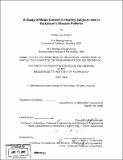A study of motor control in healthy subjects and in Parkinson's disease patients
Author(s)
Levy-Tzedek, Shelly
DownloadFull printable version (27.20Mb)
Other Contributors
Massachusetts Institute of Technology. Biological Engineering Division.
Advisor
Douglas A. Lauffenburger.
Terms of use
Metadata
Show full item recordAbstract
Parkinson's disease (PD) is a primarily motor disorder which affects at least half a million people in the US alone. Deep brain stimulation (DBS) is a neurosurgical intervention by which neural structures are stimulated electrically by an implanted pacemaker. It has become the treatment of choice for PD, when not adequately controlled by drug therapy. We introduced a novel robotic platform for the study of the effects of DBS on motor control in PD. Subjects performed discrete wrist movements with and without a force field. We found preliminary indication that motor learning may be taking place with stimulation, and demonstrated how robotic testing can augment existing clinical tools in evaluation of the disease. To study the effect of stimulation on movement frequency, we employed a rhythmic task that required movements of the elbow to remain within a closed shape on a phase plane. Three closed shapes required varying frequency/amplitude combinations of elbow movement. The task was performed with and without visual feedback. Analysis of data from the healthy control subjects revealed a non-monotonic relation between accuracy on the phase plane and movement speed. Further kinematic analyses, including movement intermittency and harmonicity, number and type of submovements (movement primitives) fit per movement cycle, and the effects of vision on intermittency were used to support the model we propose, whereby there exist two subtypes of rhythmic movement; small-amplitude, high-frequency movements are nearly maximally harmonic, and harness the elastic properties of the limb to achieve smoothness and accuracy, and large-amplitude, low-frequency movements share characteristics with a string of discrete movements, and make use of visual feedback to achieve smoothness and accuracy. (cont.) Bradykinesia (slowness of movement) is one of the hallmarks of PD. We examined the effects of visual feedback on bradykinesia. PD patients off dopaminergic medication and healthy age-matched controls performed significantly faster movements when visual feedback was withdrawn. For the bradykinetic subjects, this increase in movement speed meant either a mitigation or an elimination of bradykinesia. Our results support a role of the basal ganglia in sensorimotor integration, and argue for the integration of nonvision exercises into patients' physical therapy regime.
Description
Thesis (Ph. D.)--Massachusetts Institute of Technology, Biological Engineering Division, 2008. Includes bibliographical references.
Date issued
2008Department
Massachusetts Institute of Technology. Department of Biological EngineeringPublisher
Massachusetts Institute of Technology
Keywords
Biological Engineering Division.